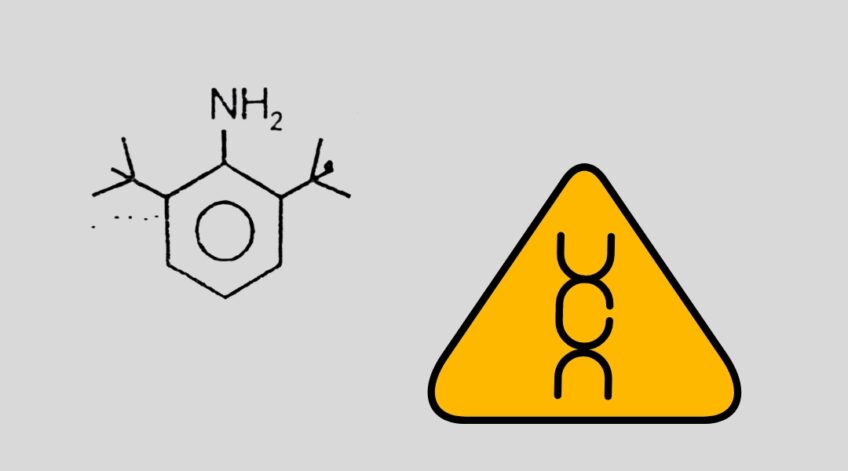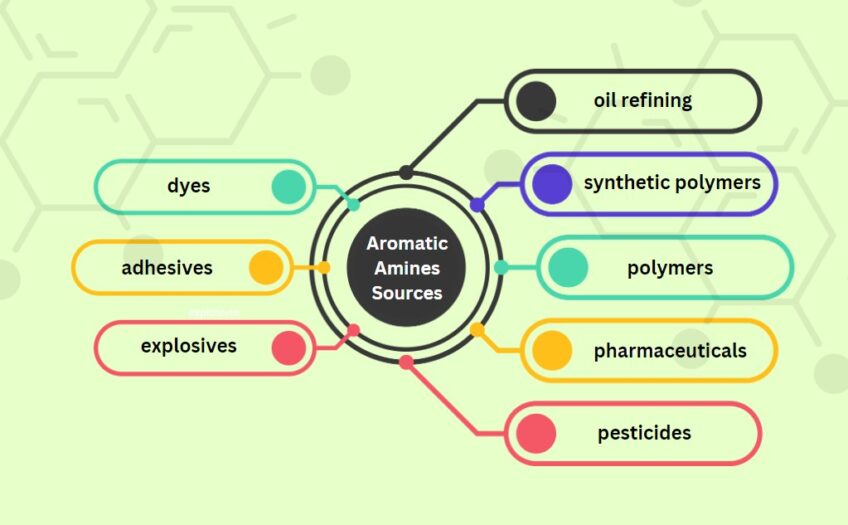Aromatic amines are chemical compounds that are commonly used in the production of rubber, plastics, dyes, pharmaceuticals and other products. Unfortunately, they are also considered to be carcinogenic, meaning they could potentially cause cancer.
In this article, we’ll discuss what we know about the carcinogenic properties of aromatic amines and what safety measures you should take when working with them.
What is Aromatic Amines?
Aromatic amines are chemical compounds that contain an amine group (NH2) connected to an aromatic ring system. They are one of the most commonly encountered organic compounds in our environment, found in many common products such as medicines, dyes, food additives and perfumes. Because of their widespread occurrence, humans are routinely exposed to aromatic amines through diet and contact with the products that contain them.
They can also be formed during the processing of proteins and some may be naturally produced by living organisms. Some of these compounds can also be found in various natural sources such as plants, animals and microorganisms. Many of them are found either as a component of certain plant extractives or in soil contaminated by industrial activities such as manufacturing leather goods or printing textiles.
Of particular concern is their potential to act as a carcinogen (cancer-causing chemical). Numerous studies have shown that exposure to some aromatic amines can increase the risk of developing cancer in humans – particularly bladder cancer and hematologic malignancies like leukemia and lymphoma.
The exact mechanism by which aromatic amines cause cancer is not yet known but scientists believe they may bind with DNA causing mutations or interacting with other molecules causing inflammation or oxidative stress that can lead to cellular damage or changes in gene expression.
How are Aromatic Amines Carcinogenic?

They are compounds found in many natural and synthetic products that can be toxic when inhaled. Exposure to these compounds can cause cancer, yet the exact mechanisms of their carcinogenic effects are still not fully understood. It is known, however, that they are metabolized in the human body to form reactive intermediates known as nitrosamines. Nitrosamines may promote tumor growth and development through several different pathways in the body.
This includes the activation of oncogenes (genes associated with cancers) and interference with the cell cycle checkpoints that control the proliferation or death of cells. It has also been found that exposure to aromatic amines can lead to DNA damage through oxidative stress, which may increase genetic mutations resulting in cancerous cell growth. Furthermore, nitrosamines have been found to disrupt epigenetic processes by modifying histones which alter gene expression and modify cellular physiology making malignant transformation more likely.
Therefore, avoiding exposure to aromatic amines is important for reducing the risk of malignancy because they are readily absorbed by the body upon inhalation or ingestion into the systemic circulation. They should be handled with caution as they can cause damage not only to ourselves but also affect our environment negatively over time if not properly managed and disposed of properly during industrial manufacturing processes.
Appropriate protective measures must be taken by regulators as well as industry workers when handling aromatic amine-containing materials or disposing of hazardous waste containing them; this will help minimize potential carcinogenic effects due to ingestion or inhalation exposure levels.
Sources of Aromatic Amines

They are organic compounds that can be found in both natural and synthetic sources. Natural sources such as plant or animal tissue, as well as synthetic sources such as dyes, drugs, and other chemicals, can all produce aromatic amines.
They are known to be carcinogenic and a cause of cancer in humans, and understanding their sources is the first step in understanding the potential health risks associated with them.
Natural Sources
Aromatic amines are a diverse family of chemical compounds that have an aromatic ring, usually consisting of six carbon atoms, and at least one amine group, meaning nitrogen atoms attached to hydrogen atoms. They are found naturally in the environment, some food and beverages, medical products and cosmetics, but can also be created during some manufacturing processes.
In terms of natural sources, some common ones include cadaverine and putrescine which are found in decaying organisms including dead animals and plants whilst tryptamines such as serotonin are present in the human brain. There are also many plants that produce biogenic amines such as ethyleneimine which is found in apples. Other organic substrates like sardines and other small fish contain high levels of ammonia from their decomposition by-products which have been identified as aromatic amine compounds.
Industrial Sources
Industrial sources of it include the production of various chemicals, such as aniline, nitrobenzene and toluene. Aniline is used in the manufacture of dyes, explosives and numerous other organic compounds. Nitrobenzene is used in the manufacturing of gasoline additives, rubber accelerators and printing inks. Toluene is used in various petroleum products, such as gasoline and paint thinners.
They are also formed during certain industrial processes that involve high heat; for example, the manufacture of graphite electrodes and welding rods produce polycyclic aromatic hydrocarbons (PAHs), which can then form into aromatic amines when they react with nitrogen oxides (NOx).
Other examples include high-temperature thermal cracking processes, such as those used to refine crude oil into motor fuel components, which can produce PAHs that subsequently form into them. Furthermore, some paints and coatings may contain mixtures of a wide range of chemical products that could lead to the formation of aromatic amines.
Finally, landfill sites sometimes contain materials containing large quantities of nitrogenous compounds; these can react with a wide variety of substances in the environment which could result in increased levels of aromatic amines.
Health Effects

They have been linked to various health effects, including cancer. This class of chemicals has been studied extensively and is classified as a human carcinogen by the World Health Organization and the International Agency for Research on Cancer.
Short-Term Health Effects
When it comes to the short-term health effects of aromatic amines, there is not much research that has been conducted. Generally, scientists have found that acute exposure to high levels of some aromatic amines can cause irritation to the eyes, nose and throat, as well as breathing difficulties in people who already suffer from asthma or other respiratory conditions. Other health effects may include headaches and nausea. In extreme cases, exposure could lead to unconsciousness or even death.
Therefore, it is important to take precautions when working with any chemicals that may contain even trace amounts of aromatic amines. Furthermore, pregnant women should avoid contact with these compounds altogether.
Long-Term Health Effects

The mention of it might evoke an image of smokers, but these carcinogenic compounds can also exist in trace amounts in your workplace or home. To understand the impact these chemicals can have on your health, we need to look more closely at how exposure occurs and what kind of long-term health effects it might cause.
Inhalation is the primary route for entering the body and it is also the most dangerous. The inhalation of fumes from furnaces, ovens, and other equipment that produces significant levels of aromatic amines can cause damage to cells by modifying DNA structure. It is well known that chronic low-level exposure can lead to respiratory problems such as asthma, bronchitis, emphysema, and eventually cancer.
Skin contact is another route of entry into the body; however occupational exposure rarely reaches levels high enough to warrant medical intervention. Though rare, direct contact with these chemicals can also cause inflammation and tenderness to skin surfaces or even lead to serious burns if there is prolonged contact over some time. Irritation may sometimes appear quickly with reddening and itching at first then gradually advancing to a more serious rash if left untreated or exposed for a long period of time.
Long-term health effects from chronic ingestion can be severe depending on the dose and total absorbed dose over a period of time due to cumulative toxicity buildup in susceptible organs such as the liver and kidneys. Long-term cancer risk from ingested aromatic amines has been linked to increased risk for various genitourinary cancers such as bladder cancer as well as lung cancer due to heavy carcinogenic exposure amongst other organ systems affected by high concentrations over extended periods.
Proper precautions should always be taken when dealing with any chemical found in low concentrations anywhere which could contain harmful compounds like aromatic amine that could potentially alter cellular activity leading to long-term issues later down the lifeline.
Risk Assessment
There are many types of aromatic amines and these molecules can be categorized based on their carcinogenic potential.
Risk assessment is the process of determining the level of risk posed by these compounds to human health. In this article, we will look at the danger posed by these compounds and how they can be properly assessed.
Occupational Exposure
Occupational exposure to aromatic amines can be significantly higher than background levels, and workers are at increased risk of long-term health effects. Workers in certain industries, such as tobacco manufacturing, rubber manufacturing, and tanning, may be exposed to higher levels of these compounds. The risk is even greater if the work environment involves a mixture of aromatic amines that could act together to increase their carcinogenic effects.
Some regulatory agencies (such as the U.S. Occupational Safety and Health Administration) have proposed regional guidelines for safe short-term exposure and facility-specific limits for long-term exposure in environments where workers are likely to encounter high levels of aromatic amines.
Such guidelines include recommendations for respirator use, monitoring worker exposures using air sampling techniques, proper ventilation systems, engineering controls, and education campaigns about hazardous substances. In addition, relevant national legislation sets occupational exposure limits for individual substances; for example the UK’s Control of Substances Hazardous to Health Regulations (COSHH).
It is important that employers consider the risks associated with using or producing potentially hazardous compounds such as aromatic amines and ensure staff is properly informed and trained on how best to control these risks.
Environmental Exposure

Researchers have been studying the effects of exposure to aromatic amines for over 50 years. While most exposure is through food, small amounts can enter the environment through industrial processes, such as dyes and printing processes. This environmental exposure can be from dust in the air and from runoff into water supplies. The IARC (International Agency for Research on Cancer) has classified some of them as potentially or probably carcinogenic to humans.
In order to minimize potential health risks, it is important to reduce environmental exposure to these compounds. One way of reducing environmental exposures is by reducing emissions and/or runoff of these substances into the environment.
Industries should take steps to reduce their emissions and waste as much as possible through treatment methods such as filtration or biological digestion of wastewater. In addition, there should be monitoring done of surface waters to ensure potential contaminants are not making their way into human or animal populations.
Finally, if working with these materials in an occupational setting it is important that safety equipment such as respirators and protective clothing are used in order to limit direct contact with these compounds.
Risk Management Strategies
Risk management strategies are designed to minimize or remove the risk of exposure to potentially carcinogenic aromatic amines in the workplace and should form an integral part of a successful health and safety program. These strategies comprise engineering, administrative, and personal protective measures, which can help to reduce the likelihood of cancer developing in workers.
Engineering controls involve introducing changes to processes or environments that can reduce the amount or intensity of exposure. Examples include installing local exhaust ventilation (LEV) systems or upgrading boilers and other equipment so that it runs at higher temperatures. Administrative controls are policies and procedures put in place to ensure workers operate safely and within any safety limits set.
Examples may include operating control rooms from outside, implementing shift change procedures, or providing all employees with easy access to online safety training courses such as e-learning programs on hazardous substances. The use of personal protective equipment is also essential for helping protect workers against exposure – this could include wearing proper respiratory protection or skin protection during work tasks that involve contact with certain hazardous substances.
It’s important for employers to assess supplier records regularly and investigate claims with authority bodies who have knowledge of potential sources of aromatic amines. Safety should be an ongoing focus point in any business environment — employee health must be both maintained and monitored on a regular basis by employers to ensure optimum performance, quality outputs and compliance with productivity requirements at all times.
FAQs

How do aromatic amines cause cancer?
They can cause cancer by damaging the DNA in cells, which can lead to the formation of tumors. They can also interfere with cell signaling pathways and cause abnormal cell growth.
What types of cancer are associated with aromatic amine exposure?
They have been associated with bladder, liver, lung, and skin cancers.
What are the symptoms of aromatic amine exposure?
Symptoms of exposure can vary depending on the type and amount of exposure. Acute exposure can cause skin irritation, eye irritation, headaches, and nausea. Chronic exposure can cause more serious health problems, such as anemia, liver damage, and bladder cancer.
How can you reduce your exposure to aromatic amines?
You can reduce your exposure by avoiding products that contain them, such as hair dyes and certain plastics. You can also reduce your exposure by wearing protective clothing and using proper ventilation in work settings where aromatic amines may be present.
How are aromatic amines regulated?
They are regulated by government agencies such as the U.S. Environmental Protection Agency (EPA) and the European Union’s REACH program. These agencies set limits on the number of aromatic amines that can be present in products and establish guidelines for safe exposure levels.
Can you still use products that contain aromatic amines?
It is generally safe to use products that contain aromatic amines in small amounts and with proper safety precautions. However, if you are concerned about exposure, you may want to consider using alternative products.
Can exposure to aromatic amines be tested?
Yes, exposure to them can be tested through urine or blood tests. These tests can detect the presence of specific aromatic amines in the body.
What should you do if you suspect exposure to aromatic amines?
If you suspect exposure to aromatic amines, you should consult a healthcare professional. They can help determine the extent of exposure and recommend appropriate treatment or monitoring.
Conclusion

Ultimately, knowing the facts about aromatic amines is essential to properly managing risk. Although research has found that these compounds may be linked to cancer, the most important thing is to reduce exposure as much as possible. That means taking measures like thorough cleaning, ventilation and safety equipment in facilities that handle aromatic amines.
In addition, it’s important to take precautions such as wearing protective clothing, being sure to wash up afterward and avoiding skin contact with any potentially contaminated items or surfaces.
It also helps to have an understanding of where aromatic amines can be found and how they are used so that potential exposure can be predicted better and identified more quickly. Knowing the facts about aromatic amines is key not only for reducing potential hazards but for staying informed on the latest research into their carcinogenic properties.

